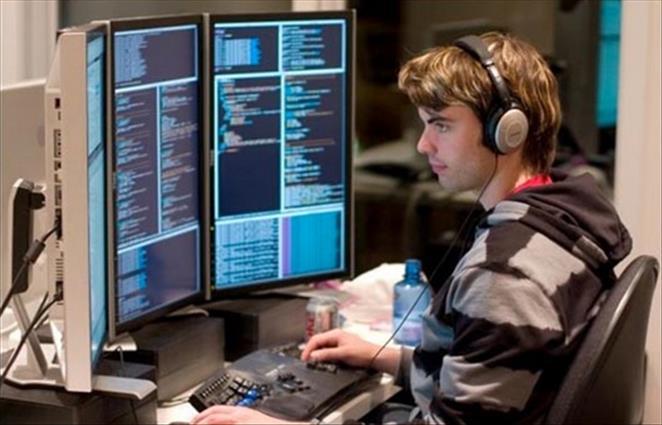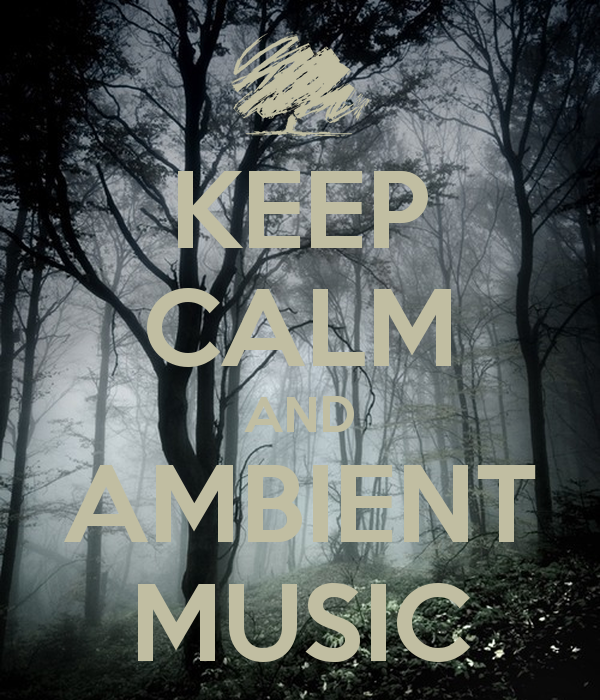[Перевод] Ambient music and its effects on writing code
In this post I«d like to talk about our background music choices for writing code. The developer soundtrack, if you will. To narrow it down, I«m going to discuss one specific genre, ambient music.

Homo laborans and music
Today the effect music has on all living creatures, humans included, is a fairly well-researched topic. It«s been common knowledge for a while that classic music helps people to calm down and relieves stress, while high-energy tunes of various genres can make your workout results way more impressive.
Plenty of scientific papers have been published that explore this phenomenon, especially by medical researchers and psychologists (use of music as a part of treatment plan, the way different organs respond to it, etc.). Naturally, many of those you gotta take with a grain of salt as there«s always the risk of crossing the line into pseudoscience, but there«s no shortage of reliable sources that confirm that link.
You don«t need to go further than Habr to find plenty of insightful articles that talk about the influence music has on a working environment and attention span of the workers. But this particular one has a slightly different intent.
I«ve been writing code for five years and listening to ambient music for about ten. Of course, there are other genres and styles I«m partial to, however, it«s ambient music that has become an essential part of the programming workflow for me. This doesn«t mean that everything I say in this post only applies to developers — it can also be relevant for anyone whose job involves any degree of mental labour. But before I start laying out my observations of the ways ambient tracks contribute to creating a comfortable space for programming, I should probably give a brief crash course for those not yet familiar with this genre of music.
Everything you wanted to know about ambient music but were afraid to ask
What is ambient music? The majority of people don«t have a clue. Popular styles that come closest to it are lounge and chill out music, both of which you can often hear in clubs and on radio. For all its variety, ambient music is a more experimental style that typically lacks both rhythm and vocals. Besides, ambient tracks are less melodic if you compare them to chill out.
Wikipedia defines ambient music as «a form of slow instrumental music uses repetitive, but gentle, soothing sound patterns», a genre that evokes «atmospheric, visual, or unobtrusive quality». This sounds about right and does a good job pinpointing the key characteristics of the genre, even though it doesn«t span all the distinctive forms its most avid fans could name. In this post I«ll be using the term «ambient music» to refer to some sister genres as well, such as Dark Ambient, Space Ambient, soft IDM and others. We«ll have a more detailed overview of the genres a bit later.

Ambient music often overlaps with other genres so you«ve definitely heard it somewhere in one form or another. Many of movie and game soundtracks are pure ambient. Some popular artists that normally work in other genres have an ambient track or two (Depeche Mode or Radiohead, for instance). You could also hear ambient music in news intros, ads, in the background of podcasts and so on. Long story short, you«ve already been exposed to ambient music even if you couldn«t tell at the time.
Ambient and code or: how I Learned to Stop Worrying and Love 10-minute white noise tracks
The way we perceive the world around us is always subjective, and when it comes to tastes in music this statement becomes particularly relevant. So I have to stress that this post only sums up my own feelings on the subject that are in no way guaranteed to perfectly mirror yours. Still, I believe this approach that incorporates music into work processes can be helpful for others too.
In my opinion, writing code is an activity that demands a certain level of consistent focus, but not relentless and utmost concentration over long stretches of time. Our thought process should be flowing at a moderate pace, and the emotional landscape for programming (in a perfect reality) should be the one of tranquility and mindfulness. The famous theory of the «flow state» essentially echoes all this. Naturally, I«m aware that cases differ and sometimes programmers turn into violent beings that punch their keyboards whenever something doesn«t work as planned. But let«s take a scenario where work environment is non-chaotic (and here we loop back: the right choice of music can help with maintaining a peaceful atmosphere).

Composing music on an old analog mechanical keyboard is somewhat similar to coding
I consider reducing distractions to absolute minimum an important part of building a comfortable workspace. And that«s why I hardly can listen to tracks that have lyrics while working: processing the text diffuses focus which is a big roadblock for writing code. For me it«s like reading a book and listening to the radio at the same time. Two data flows merge into one, making you skip words and miss chunks of audial information.
It«s the same with programming. Writing code is a lot like writing any other text — a note or a paper. Sometimes the lyrics happen to ping you on emotional level, you start listening closely, lose track of what you were doing and then have to return into the right mindset. The ability of taking in information from multiple sources without hiccups of this sort can probably be developed, but why make things more difficult for yourself? With all this in mind, I try to avoid news or any kind of spoken text in my workplace soundtrack.
One exception from this rule are the types of ambient music that use voice samples (radio records, fragments of movies or TV shows). In their case the vocal part gets woven into the instrumentals in a way that transforms it from one of the driving elements of the track to just another layer in the ambience. For some examples of ambient music with voice samples I can name Boards of Canada, Biosphere, eyesix.
High-energy, dynamic tunes are a poor fit for coding — or at least, I«ve found it to be the case. I get the impression that a fast tempo and a whimsical rhythm (be it electronic music or rock) make me rush my work: there«s that urge to keep pace with the music and no incentive to stop and think. This aggressive style of programming might have its fans (in a way, this too can be considered a flow state) but personally, I find it more helpful when it comes to tasks that take physical work. Like digging up potatoes to The Prodigy.
Getting into the right mood with ambient music
As I«ve mentioned above, the effect music has on people’s emotions and inner state, the strong connection between them is a long-established fact. If you«re feeling perky, you«ll find melodies that reflect this elevated mood of yours streaming from the earbuds. Or maybe even speakers, if you feel like sharing the joy (make sure you don«t go overboard with the volume though). If you feel like taking a breather and stepping away from all the mundane cares and fuss, serene easy listening would work best for that. The same principles apply to getting into a proper headspace for work, to the point that there«s a vast collection of albums and playlists specifically tailored to job-related activities of various kinds (you can find them on streaming services). Ambient music features heavily in those playlists.
Ambient music encompasses a number of different styles and not all of them will be appropriate for work. Say, Drone ambient is basically low-frequency humming — such incessant audial pressure certainly won«t do any favours for your ability to think and code. For this reason, I recommend going for «lite' ambient music. Here«s an abridged «manual» that will help you to find the right genre that will be compatible with your job.
If you have never listened to ambient music before, it«ll be a good idea to start with simpler, more conventional styles: an unfortunate run-in with something too daring might turn you off the entire genre for good.
In my opinion, some of the most appealing (and comprehensible) compositions are published under the French label Ultimae Records. They make music in the psychedelic ambient genre (Psybient or Psy Chill) that«s marked by pleasant melodies and beautiful, balanced structure. This genre often touches on the topic of space, both inner and outer. I recommend trying Solar Fields (he has albums in trance genre as well, don«t get them mixed up), Carbon Based Lifeforms, Asura.
If you«d rather have something more upbeat that has a touch of rhythm to it, you might appreciate ambient house, downtempo and dub ambient. This music feels more positive and sunshiny, with a low-key beat of the Reggae and dub origins. My personal recs are The Orb, Ott and Future Sound of London.
For those moving onto more saturated forms of ambient, ambient techno is worth looking into. This style can even be considered dance music. The compositions are build around drum machine loops with characteristic keyboard overtones. I highly recommend listening to Selected Ambient Works 85–92 from Aphex Twin, The Black Dog, B12.
There«s also classic ambient, defined by the work of several notorious composers. This subset fully represents the multifaceted nature of ambient: the music varies a lot in form and tone. Classic ambient is based on the use of ambience recorded in assorted locations and certain kinds of musical instruments (old analog keyboards come to mind). The «first man» of classic ambient is Brian Eno. In fact, it was him who put the term «ambient music» into circulation. Aside from him, Steve Roach, Robert Rich, Klaus Schulze and Pete Namlook are all worth giving a listen to. Every one of them has an immense discography with plenty of works in various genres.
Some styles of ambient barely have an instrumental element at all. A striking example of those is field recording. The artists working in this genre don«t compose music in the conventional sense, they just grab a highly sensitive microphone and head into the woods to record ambience. That«s the most natural music you«ll ever find. Among the popular representatives I can name Biosphere, a techno ambient artist whose tracks has a unique atmosphere that takes you straight to the mountains above The Arctic Circle.

Artist Biosphere in his natural habitat
In conclusion
Getting into the right headspace for work is extremely important, especially if you job is related to programming, which requires tranquility and focus. I know every one of you writes code to the soundtrack of your favorite tunes that can belong to any and all genres, but try to reconsider the relationship between your playlist and your productivity levels. Try a new approach to shaping your environment. Try programming to ambient music.
